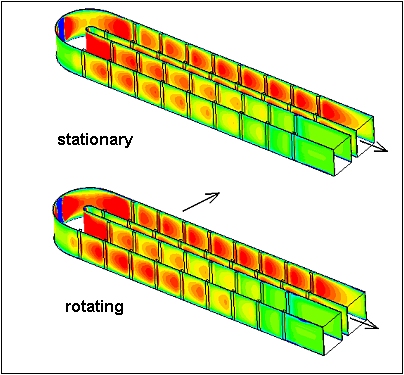 |
NUMERICAL CALCULATION OF INTERNAL COOLING, TURBINE BLADE |
| PhD student: |
Jonas Bredberg jonas.bredberg@volvo.com |
| Supervisor: |
Lars Davidson lada@chalmers.se |
| Cooperation: | GTC |
| Sponsors: | STEM, ALSTOM Power, Volvo Aero Corp. |
| Publications: | [1-11], see reference below |
| Start of project: | spring 1997 |
| End of project: | June 2002 |
THE PROJECT In recent years there have been an increased attention toward more complicated turbulence and heat transfer models in predicting the characteristic of turbomachinery. This have followed from numerous experimental tests where it have been shown that contemporary models (such as eddy-visocosity models) fails to predict the complicated flow behaviour within the internal structure of rotating turbomachinery. The economical savings by increasing the turbine entry temperature (TET), is significant. An increase in TET could be made possible by accurately predict the internal cooling. Research on internal cooling is thus of great importance for gas turbine industry. The internal flow of a rotorblade is generally influenced by rotational effects (Coriolis, inertial) and temparture effects (buoyancy) in addition to complex geometry (turbulators, bends). All these effects can not be modeled through an eddy-viscoisty model, and necessitate a second order closure, RSTM or ARSM. NUMERICAL METHOD In this project the main focus will be to understanding the physics, with the aid of state of the art turbulence models. The complexity of the geometry will be kept at an elementary level, although incorporating the characteristics of the internal structure of a rotor blade. A number of different turbulence models are used including EARSMs (Gatski and Speziale, Wallin and Johansson) and two-equation models (mainly Wilcox based). The near-wall behaviour, which is of vital importance for heat transfer, is modelled using either an one- equation model (Wolfshtein) or a low-Reynolds number two-equation model. A domestic finite volume code (CALC-BFC) will be used, which utilize non-orthogonal co-located grid, cartesian velocities and SIMPLEC pressure-velocity correlation. Initial (up until spring -98) only 2-D calculations on rib-roughened channel were made using a 2-D version of the EARSM code and the Boussinesq based EVMs, in order to understand basic phyics. Later (autumn -98) a visit was attended at UMIST, Manchester (Prof. Launders group) where the calculations were extended to 3-D. During spring/summer -99 the licentiate was written and presented. As for now (autumn -00) computations are made on rib-roughened u-bends, using the most promising and efficient turbulence model tested previously. Research is also being made on modifications and improvements to these models. A 64-processor Origin 2000 Silicon Graphics machine is used for the computations. This project is supported by Statens Energi Myndighet, Alstom Power and Volvo Aero Corporation REFERENCES - click
|
|
This page, Numerical Calculation of Internal Cooling, Turbine blades, should be part of a frames system at www.tfd.chalmers.se/~lada/projects/proind.html by Webmaster: Inga-Lena Ljungström ilj@flowsim.se |